The product was loaned to me for the review purpose in exchange for my honest opinion. The review was originally posted on my
site, and now I would like to share it with my readers on Head-fi.
Manufacturer website:
Astell & Kern, Available for sale directly or from on-line retailers like
Audio46.
Intro.
Looks like I can’t use “when hell freezes over” anymore when talking about Astell & Kern DAPs. In October of last year, they finally introduced 4.4mm BAL output, in addition to Wireless LDAC protocol, in an all-new KANN Alpha DAP. And if you thought it was just a fluke or one-time thing, here comes the latest A&futura series SE180 modular DAP release with LDAC and 4.4mm BAL, along with 2.5mm and 3.5mm, on stock SEM1 and optional SEM2 modules.
SE180 announcement caught everyone by surprise, and not only because of LDAC and 4.4mm BAL output, but also a modular DAC/amp design and a reduced price. While A&K didn’t exactly reinvent the wheel here with a modular dac/amp design, they improved it and set a high bar to even challenge their current flagship. Years ago, DAP competition was less fierce. Today is a different story with a highly competitive market, and A&K responded with a highly competitive product release.
I received SE180 as a loaner for 2 weeks because this is the first and the only demo unit available in US now, and I appreciate the opportunity to test it. I didn’t have time for a lot of my usual pair up and comparison examples, but I still tried to cover as much as I can to paint a detailed picture of this new A&K DAP from A&futura series. So, let’s take a closer look at what I found.
 Unboxing and Accessories.
Unboxing and Accessories.
I received SE180 without a packaging box, just the chassis and SEM1 and SEM2 modules, so there is nothing to write about the unboxing experience or accessories. I’m sure packaging will be similar to SE200 or other entry and mid-fi level A&K DAPs, probably including a manual, a few sets of screen protectors, and a premium quality charging/data usb-c cable. I don’t expect leather case to be included since I don’t recall seeing SE200 unboxing with a leather case. Would love to be proven wrong, but SE180 is cheaper than SE200 and I expect it to follow the same footsteps.
Design.
I think many audiophiles are well aware that A&K pays as much attention to the sound tuning as they do to chassis design of DAPs. All of their players have a unique signature look and solid build, and sometimes you don’t even feel like hiding it inside of a leather case. To me, their flagship A&ultima SP2000 has a more formal classy look, while their “entry” level SR25 A&norma pushes the envelope with a funky tilted screen and slightly tilted sides design. SE200 also has a unique tilt of the chassis when you look at the side profile and a sculptured wavy line around the volume wheel.



SE180 picked up a lot of cues from SE200 design. The same size screen (5”) and overall dimensions are close, 77x137.2x19.9mm, just a little taller and thicker due to a modular design which contributes to 380g of weight (100g more than SE200). SE180 also features tilted chassis sides and a little less pronounced wavy line around its LED volume wheel with multi-function light that lit up with red (16bit), green (24bit), blue (32bit), and purple (DSD) which can also be disabled. The wheel itself has a signature A&K watch crown design with a precise click action control as you turn the volume up/down using your thumb. But what I found atypical here is a single playback physical button with functionality of single click to play/pause, double click to skip forward, and triple click to skip back.
You no longer going to find 3 separate buttons on the opposite side from the volume wheel, and you also going to lose being able to fast-forward/back by holding separate skip buttons. It took me a minute to get used to this new multi-control button, typical control of wireless headsets. Afterwards, I found it quite intuitive and convenient since I was able to control the volume and the playback using my thumb due to their close proximity to each other. The only thing I was missing is pushing the volume wheel to turn display on/off. For that you have to reach to a power button located at the top of the DAP. I’m so used to SP2000, that I continued to push the volume wheel on SE180.
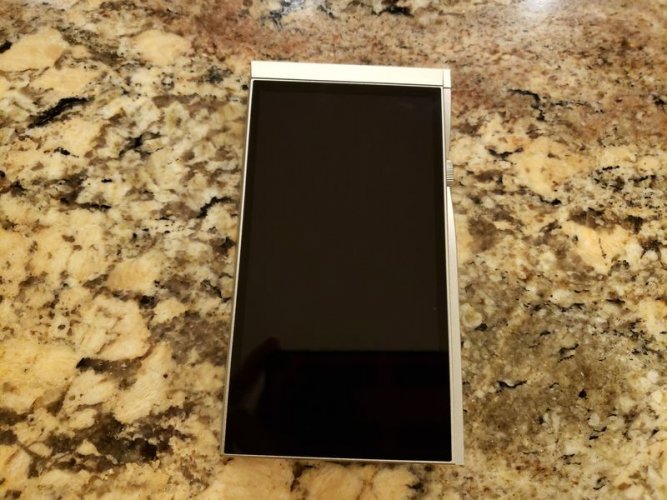





With volume wheel and playback multi-function button on the right side, the left side is empty. At the bottom of the DAP, you have usb-c multi-function port used for charging, file transfer, USB DAC in connection, and USB Audio out connection. Next to it is the spring-loaded micro-SD card slot to expand the internal storage. The top of the DAP is where you will find a new major element of SE180 modular design – that is where the actual module goes in. And at the top left and right corners of the chassis sides you will find small release buttons you have to push in to release the DAC/amp module. Unlike other modular designs with 2 screws holding the module down, here you don’t need any tools.
I will go into more details about the modules in the next section, but do want to mention that stock SEP1 module and optional SEP2 have the same look and the same ports, featuring single ended 3.5mm and balanced 2.5mm and 4.4mm headphone/LO outputs. Each module also has a power button used to turn the display on/off as well as power down/up the DAP. One thing to keep in mind, SEP modules are
not hot-swappable. Once you remove a module, SE180 will power down and you will have to turn it back on after inserting a new module.


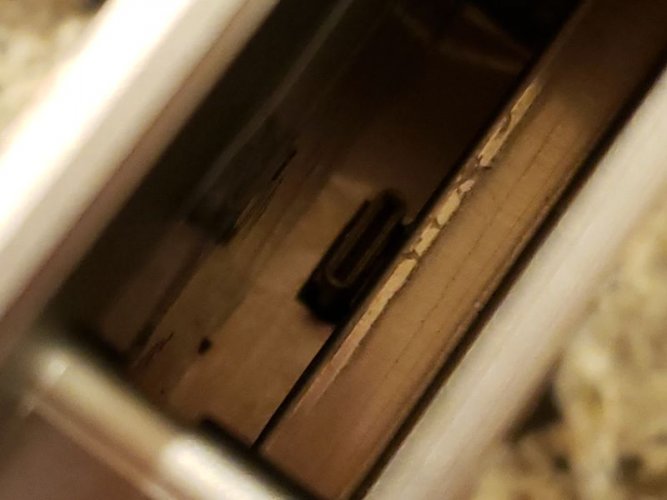 Under the hood.
Under the hood.
As one can imagine, the first thing that stands out from under the hood is the modular design and 2 removable interchangeable modules. While SE200 had multi-DAC design, SE180 modular design allows you to completely remove and replace a card with another DAC/amp combo.
The default SEM1 module has
ES9038Pro DAC and comes with 3.5mm SE (1ohm output impedance) and 2.5mm/4.4mm BAL (1.5ohm output impedance) outputs that can function as either Phone Out or Line Out. In addition to providing access to digital filters of corresponding DAC, for the first time I also see access to change the gain, either Normal (SE 2Vrm, BAL 4Vrms) or High (SE 3Vrms, BAL 6Vrms) which going to be useful for IEMs with higher sensitivity.

The optional SEM2 module will come with
dual AK4497EQ DAC, and also has 3.5mm SE (1ohm output impedance) and 2.5mm/4.4mm BAL (1.5ohm output impedance) outputs that can function as either Phone Out or Line Out. Similar to SEM1, you have access to digital filters of corresponding DAC and access to change the gain, either Normal (SE 2Vrm, BAL 4Vrms) or High (SE 3Vrms, BAL 6Vrms) which going to be useful for IEMs with higher sensitivity.

It is not coincidental that A&K selected ESS module to be default since audio market is still recovering after AKM factory fire and experiencing AKM DAC shortage. Based on what I heard, while SE180 with SEM1 should be shipping soon, availability of SEM2 module is delayed until July.
Both modules yield about
10hrs of playback time on 3,800mAH LiPo battery. I didn’t have enough time to test battery endurance under different conditions, but from my experience of testing other A&K DAPs, this number usually holds true using average sensitivity IEMs from balanced output while playing FLAC files in the loop with display mostly off. This battery life is no different than SE200 using AKM output. Another thing to keep in mind, while both DACs support all the popular formats, such as WAV, FLAC, WMA, MP3, OGG, APE, AAC, ALAC, AIFF, DFF, DSF, MQA, SEP1 w/ESS goes up to DSD256 while SEP2 w/AKM goes up to DSD512.
The rest of the features are common, such as internal 256GB and storage expansion with microSD (Max 1TB). The touch display in SE180 is 5” like in SE200, but the resolution went up from 1280x720 to an impressive 1920x1080. You will also find a support of BT5.0 Wireless standard that includes both aptX HD and LDAC (while SE200 had BT4.2 and only aptX HD). Plus, now BT supports both Tx and Rx. Unfortunately, there is only 2.4GHz Wifi band, wish they would implement a dual with 5GHz to improve the connectivity. Still OpenApp support to load a number of popular streaming apps, but the Android OS is closed and if I’m not mistaken, based on Android 9.0 with additional sound optimizations.
 GUI.
GUI.
When it comes to A&K DAPs user interface, once you get familiar with one, you will feel like at home using all of their DAPs. Basically, they all share the same interface, even SR25 with its smaller display uses the same GUI, scaled down to fit its screen. But as soon as I powered up SE180, I noticed right away a new addition. Instead of a touch home button underneath the screen (no longer available in SE180), A&K added Navigation Bar at the bottom of the display with a name of a currently playing song, Home button, and Play/Pause and Skip buttons. It is always visible and makes it easy to get back to the main Playback screen or to control the playback from any other screen. The Floating Back button is still there and can be easily disabled by dragging it to the middle of the display or disabled in the Settings menu under Input Method. The button itself could be moved to anywhere along the left/right sides of the screen.

Once you press Power button, you are greeted with “A” logo and arrive to the main Playback screen. The embedded artwork (with cover art) window occupies top half of the screen, tapping on it expands the view and shows lyrics if one is available. Swiping artwork window left/right skips to prev/next song in your playlist. Above it you get a summary of song format (file type, bit depth, and sampling rate), with a link to Now Playing (where you can edit/modify from within) in the upper right corner and a link to Navigation Menu in the upper left corner. Right under the artwork window there is a thin strip of transport control to fast forward/back by swiping through it. You no longer have physical buttons to fast forward through the song, so it is either swiping the transport bar or holding the Next/Prev touch buttons. And in the lower half of the screen, you have a row of controls, additional song info, and playback touch buttons.

The Navigation menu, accessible by pressing “A” in the upper left corner, takes you to a list with various Sorting option (song, album, artist, genre), Playlist, Folder view, MQS, CD library, Services (streaming), and Settings. You can also access this screen by swiping display to the right from the main Playback screen, where youh can also swipe to the left and get into Now Playing screen. Under every sorting option you have other options to add songs to playback queue, different layout to view album (single, double, or triple columns), view artist with every album under each name, genres according to id3 tags, and my favorite Folder browsing which also gives you extra info about internal storage.
Settings menu is very important, but you can also access some of the shortcuts by swiping the screen down to see what’s available in Notification bar area where you can toggle Wi-Fi, Bluetooth, EQ, USB mode, external usb, AK connect, Line Out, Car Mode, Wheel lock, and shortcut to the main Settings menu. Many of these toggle options don’t just enable the function, but if you long press it will take you to the menu of that function. In the main Settings screen, you have Wi-fi, Bluetooth and Codec selection, AK Connect and File Drop, then Equalizer, Gapless, Line Out, L/R Balance, Playback setting, Notification Panel, AMP (normal and high gain), CD ripping, usb mode and usb audio, Car mode, DAC filter (digital filters associated with particular SEM# dac), and other system settings.
With EQ, you have one blank EQ preset and no other genre specific presets. EQ interface has two modes: Main and Advance. In the Main you have standard Paragraphic EQ sliders for 20 bands (30, 45, 60, 90, 120, 180, 250, 380, 500, 750, 1k, 1.5k, 2k, 3k, 4k, 6k, 8k, 12k, 14k, and 18k) where you can either slide the bar or use a precise 0.1 adjustment, as well as scrolling through available frequencies. As you adjust, it gets reflected in the lower right corner, showing the overall shape of EQ. Switching to Advance, turns EQ adjustment into Parametric EQ with a full GUI view of EQ shape where underneath you have FREQ band selection (a choice of 20), Gain selection in 0.1 and 0.01 steps, and Q bandwidth. Since bands frequency is fixed, I consider this to be semi-Parametric EQ. The interface looks great and the actual adjustment finally has a more noticeable effect on the sound.
 Open APP Service.
Open APP Service.
Open APP Service is implemented in all A&K Android based DAPs, including SP1000 SS/CU, SP1000M, SE100/200, SR25, and SP2000 SS/CU, with SE180 being no exception. More info could be found
here, where Astell & Kern goes into details about how to install and to use it.
When you start dealing with Android apps, in many cases you do need a Back button for navigation, so Floating back button come in handy when dealing with streaming apps. While Astell & Kern offers a built-in Tidal service (without off-line storage support), for a long time their customers been asking to add Spotify, Qobuz, Amazon and other streaming services. A&K latest DAPs do run on Android, but it's a heavily modified closed OS without access to Google Play. In a way, it's a blessing for a manufacturer to keep DAP performance optimized since you don't have to worry about customers installing and running other unstable apps.
If you decide to install a non-blacklisted app, you need to download APK file (use a site like
https://apkpure.com/), copy it to Open Service Folder located on internal storage, go to Services on the DAP, and when you see the app being recognized and listed in there, click to install it. Keep in mind, for example, you will have to install Tidal apk if you want off-line downloads. Also, installed apps will not be updated automatically since you are not running Google Play. You will have to keep track of app updates and manually download and install new versions.
I installed and used without a problem Amazon Music HD and Qobuz.
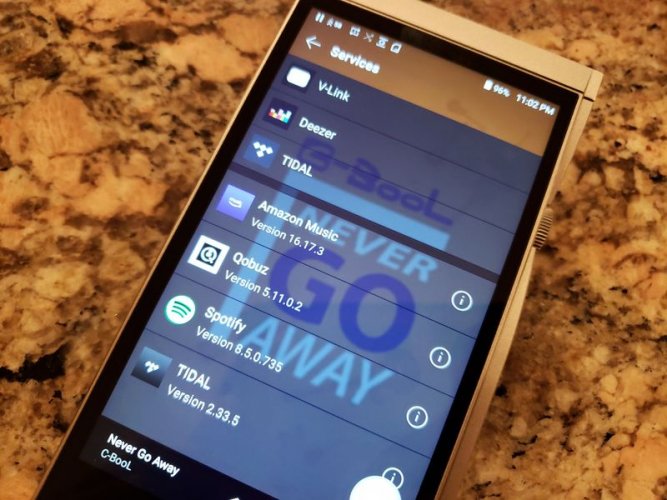 Sound Analysis.
Sound Analysis.
The sound analysis of SE180 was done using Oriolus Traillii, playing a selection of test tracks, such as Agnes Obel “The curse”, Sandro Cavazza “So much better” (Avicii remix), C-Bool “Never go away”, Ed Sheeran “Shape of you”, Alan Walker “Darkside”, Galantis “Hunter”, Iggy Azalea “Black widow”, Indila “Boite en argent”, Dua Lipa “Love again”, Counting Crows “Big yellow taxi”, David Elias “Vision of her”, and Michael Jackson “Dirty Diana”. I was told that each module had about 60hrs of playback time when I received it, and I put another 20-30hrs on each, thus plenty of burn in time.
I prefer to describe the DAP sound based on the comparison to other DAPs and pair ups with different IEMs/headphones since the DAP by itself doesn’t have a “sound”. What we hear is how it sounds through connected IEMs/headphones or the difference in sound relative to source comparison using the same pair of IEMs/headphones. This is my subjective opinion, describing how
I hear it while analyzing the sound difference between SEP1 (SE180ESS) and SEP2 (SE180AKM). One thing to note, it will heavily depend on what you are testing it with since in some pair ups the difference was more noticeable while in others it was more subtle.
SE180ESS vs SE180AKM - AKM card has a more revealing tonality and more transparency in sound (less coloring) while ESS card sounds a little smoother. One of the reasons why I hear it that way because to my ears AKM card has more sparkle in treble while ESS card has a slightly stronger bass impact and smoother treble. From a technical perspective, AKM card sound is tighter, faster, with a blacker background and faster transient of notes, while ESS is more relaxed, laidback, more soulful in comparison to AKM card. Also, AKM card has a wider and more holographic soundstage while ESS gives sound a more intimate feeling with a slightly narrower soundstage expansion. ESS module soundstage is still wide, but relative to AKM module I found the latter one to be wider.
You will get two different tuning flavors depending on your pair up preference. And, each card has a full set of shared headphone/line out ports, normal and high gain setting, and access to digital DAC filters.
2.5mm/4.4mm (BAL) vs 3.5mm (SE)
Just like in my testing with other A&K DAPs, the difference in power output is definitely noticeable when going from SE to BAL where I always have to lower the volume. Another noticeable difference is BAL output having a wider soundstage and blacker background. Other than that, the sound signature and tonality are nearly the same within corresponding module.
 Comparison.
Comparison.
In every comparison I used Oriolus Traillii, volume matched while listening to the same test tracks between DAPs. Also, for a more meaningful comparison I tried to match other DAPs with either SE180 ESS or AKM based on similarities in sound signature. Furthermore, I only covering the difference in sound as
I hear it, not the design and other functionality.
SE180AKM vs Hiby R8 - didn't expect it to be that close, but it was nearly impossible to tell them apart in a blind test. These DAPs have the same tonality, the same soundstage expansion, and the only difference I can pick up is a little more air/sparkle in pair up with R8, but I could be splitting hair here. In a blind test I got them wrong more than half of the times. Both use AK4497EQ x2.
SE180ESS vs Cayin N6ii w/E02 - nearly the same tonality, being smoother and more soulful, with the main difference of SE180ESS being a little more neutral and balanced while N6ii w/E02 having a slight lift in mid-bass, giving the bass more impact. Another variation is N6ii w/E02 having more width in soundstage (similar to SE180AKM), with the sound stretching wider while SE180ESS has a more intimate soundstage expansion where it sounds like you are a few rows in front of the performer. Both use the same ES9038Pro dac and have replaceable DAC/amp cards.
SE180ESS/AKM vs iBasso DX300 - this one is a little trickier because I feel like DX300 fits somewhere in between of comparison to ESS and AKM cards. The bass of DX300 has impact similar to ESS card, while its tonality is closer to AKM card due to having more sparkle and more revealing sound presentation. Also, DX300 soundstage is closer to AKM card than ESS. Thus, I couldn't narrow it down if DX300 with its CS DACs fits closer to ESS or AKM cards. SE180 has replaceable DAC/amp while DX300 has replaceable amp card only.
And last, but not least…
SE180 AKM vs SP2000 SS - SP2k has a better technical performance with more 3D soundstage expansion and better layering of sounds with more air between the layers. The tonality is very similar to AKM and a little more revealing than ESS. SP2k treble has more sparkle and air which improves the sound layering in comparison to both AKM/ESS cards. Also, SE180AKM has a slightly narrower soundstage while the gap in soundstage expansion with SE180ESS is even more noticeable relative to IEMs I tested it with. SE180AKM uses AK4497 while SP2k uses AK4499. And it actually makes you wonder that in theory they can make another dual AK4499 dac/amp card and tune it identical to SP2k.
 Pair up.
Pair up.
Here is how SE180 pairs up with some IEMs and headphones. Unfortunately, this is going to be a very short section of the review because I didn’t have as much time to go over different pair ups and spent more time using Traillii for sound analysis in comparisons above. Thus, these are just brief notes.
I found SE180 to drive full size headphones, regardless if it is high impedance or planar or full-size dynamic driver, with the same authority as SP2000 SS. And with full size cans the gap in sound performance using SEP2 (AKM card) was less noticeable between SE180 and SP2000 SS. As a matter of fact,
Meze Audio Empyrean (planar) was driven better by SE180AKM then SP2k, with tonality being more transparent and the sound being more detailed. But
Audio-Technica R70x (470ohm) and
Beyerdynamic T5p (2nd gen) were driven and sounded nearly the same between SE180AKM and SP2k.
With IEMs, I spent more time testing with
Oriolus Traillii and enjoyed more revealing nature of SEP2 (AKM) module, but with IEMs it will come down to pair up synergy. Brighter and more revealing IEMs paired up better with a stock SEP1 (ESS) card, while I preferred a pair up of more neutral and warmer tuned IEMs with SEP2 (AKM) card. But either one worked fine. Of course, if you want to squeeze out every ounce of technical performance, SP2000 is still at the top, but compared to SE180AKM the gap was not as big.
And for those who are curious, neither SE180ESS nor SE180AKM hiss with sensitive IEMs like
Campfire Audio Andromeda or
Solaris.
 Wired and wireless connections.
Wired and wireless connections.
Besides being a portable DAP, you can expand SE180 functionality as a transport to drive external DAC/amp, to use external AMP, or to turn the DAP into wired/wireless usb DAC. And of course, you don’t have to be limited to wired headphones, and can take advantage of Wireless Bluetooth connection.
Wireless/Bluetooth.
I tested SE180 BT Tx with various headphones; SE180 paired up within seconds and had the acknowledgement message on the screen to indicate which codec was used. I was able to change volume from SE180 and from wireless headphones, as well as control the playback and skip tracks remotely. Wireless connection worked about 30ft away from SE180 in open area.
SE180 also has Bluetooth Sink Mode to enable BT DAC “Rx” mode to use SE180 as a wireless DAC. Once turned on, I was able to find and pair up with SE180 from my Galaxy smartphone and set LDAC codec.
 USB Audio Out.
USB Audio Out.
Connected to L&P W2 USB DAC/amp without a problem. In notification bar of SE180 have to be sure External USB is selected to enable USB Audio mode. Volume was fixed on SE180 at 150, and I can adjust it from W2. The sound characteristics was typical of W2 DAC/amp while using SE180 as a digital transport.
USB DAC.
Recognized right away by my ThinkPad T480s (Win10Pro). In notification bar of SE180 have to tap USB Mode to select DAC. Volume can be adjusted from Laptop or SE180. No need to install any additional drivers, and the sound was typical of SE180 headphone output.
Line Out.
Connected to
Cayin C9, I had to select Line Out from notification bar and was able to control the volume from both external amp and SE180. If you need to color your sound with an external amplifier or need to drive more demanding headphones, access to LO is convenient. Plus, I was finally able to use 4.4mm to 4.4mm interconnect cable from SE180 without any adapters.
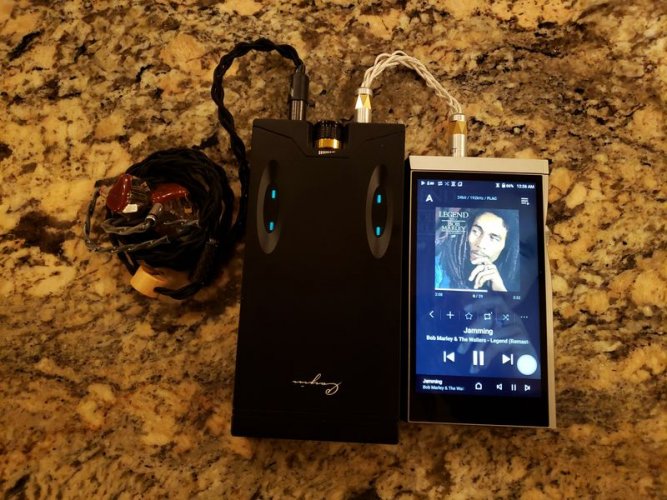 Conclusion.
Conclusion.
You can probably sense from my review that I was impressed with this new release. Last year A&K stepped it up with SR25, and now did it again with SE180, blurring the lines between their entry, mid-fi, and summit-fi DAPs. There is no longer a big gap in performance based on the price alone. And if I were A&K, I would narrow down their product line to SR series as a small, portable, all-day battery, entry/mid-fi level pocket warrior. Then, combine SE and SP series as their swiss army knife modular flagship, including high resolution upper end modules to bring it closer to SP flagship level of performance. And keep KANN series for those who need a more powerful output to drive demanding headphones with a desktop level performance in a pocket.
Regarding SE180, A&K took the concept of their SE200 dual dac/output model and expanded it into a modular design while actually lowering the price, though SE180 with stock SEM1 and optional SEM2 modules cost nearly the same as SE200. The modular design has a clever release mechanism that doesn’t require screws. Furthermore, both modules come with 3.5mm SE and both 2.5mm and 4.4mm BAL outputs, something A&K fans been wishing and praying for years. LDAC wireless protocol is here to stay as well. Plus, you have other improvements not available even in some of their previous flagships, such as access to gain control and DACs digital filters, a more noticeable semi-Parametric EQ adjustment, and a brand-new Navigation bar. It is an impressive design and a great A&futura series update. Makes you wonder, if they put so much work into SE180, what are they going to come up with in SP series next?







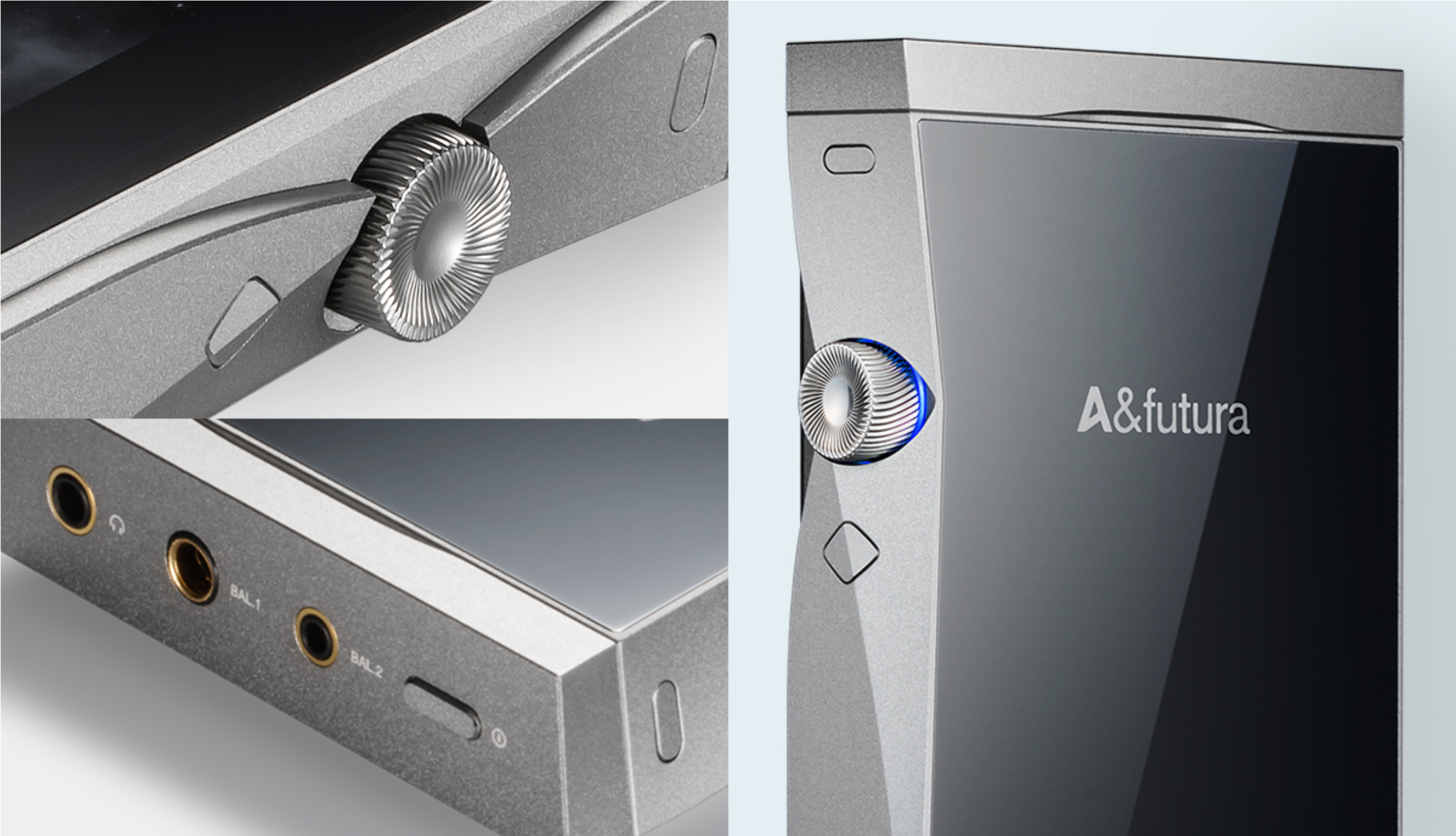

















































Also, your music choices are top notch, thank you very much!